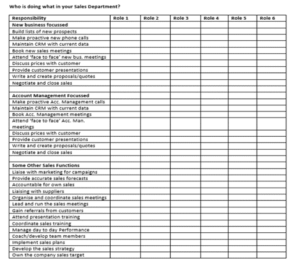How to get Sales back on track? Is it time to recruit, train, or revaluate your process?
When your sales team isn’t performing at the level you want and your growth is failing to meet targets, intuition may say to look and hire an experienced ‘super sales person’ to lift your business out of the sales doom and gloom. However, recruitment is expensive and there are a few less fiscally risky things to check out first.
Identify that you do actually need a new sales person
Evaluating the effectiveness of your current sales team mix is a crucial first step. Using a skills audit grid to outline the roles, skills and experience you need, matched to your current staff, will soon reveal what skills you have in your team and pinpoint if you do have a skills gap. If the team have the skills, it could mean a reshuffle, rather than a new hire.

Part of the skills audit is making sure the sales roles you currently have match your needs. These will depend on the size of your company, your industry, your customers, their buying journey and your channels to market. It’s likely that external events and changes in your competitive market will influence the roles you need in your team. Your business may suit an overlap of traditional roles or something completely unique.
Be very clear what you’re hiring for and what you are paying for. Competency and personality profiling can help match candidates to the role. They give an insight into the candidate’s behaviour and what they naturally gravitate towards. There’s no point hiring a new sales person to work on new business, if their profile indicates it’s not their strength, e.g., when you want a person to win new business but they are more experienced in, and suited to, Account Management.
Because recruitment is a hit and miss venture, it can be tempting to load up junior and senior sales roles with additional responsibilities. It can be effective, but if you’re expecting your team to embrace accountability and responsibility, it’s vital to make sure you’re not pushing them beyond their ability to deliver.
Example
You decide to catapult an ambitious junior sales person into more senior sales role. Stretching the role is fiscally very appealing. Paying less, getting more. Unless you’re sure they’re ready, you’re gambling with real customers who have the potential for lifetime value. Senior sales roles are usually focused on the later stages of the buying journey and should be filled by people with more experience and wider sales skills. The stakes are higher and the responsibility is greater because significant time and money will have been invested in winning the business.
Is recruitment the only way to achieve what you want?
Think about your strategic and long-term goals, over and above reaching your sales and growth targets and align them to your company mission and vision. If you make your objectives realistic, measurable and easy to communicate to your team, the actions you’ll need to achieve them will be clear. Depending on what they are, it may not be a new sales person you need. A redesign of the sales team to suit current needs is a far better option and a better long-term strategy than regular recruitment.
Don’t rule out the idea of outsourcing elements of the sales process. It might not be your ideal long-term plan, but it can be a valuable interim solution to an immediate challenge. I meet some great businesses who are able to provide well needed support to certain facets of the Sales and Marketing process.
What about internal promotion?
In addition to a sales skills audit, regular performance and development reviews, even informal ones, will help you assess your salespeople individually and as a team. While training is focussed on learning specific product and selling skills, development should be a longer-term process with benefits for the individual, the team and your business. They are most effective when conducted one on one, with a documented record of the discussion, agreed by both attendees. This is a valuable record of progress, attitude and skills, creating a full picture of each person’s development for the duration of their employment.
A development review can be used as a career guide, showing a sales person what they have to achieve to be considered ready for promotion. Used as a management tool, they are an accurate guide to where each team member is in their career cycle and their expectations. This will be a great advantage if you decide to juggle roles and responsibilities to meet your sales targets. You may find you can achieve what you want with your existing staff, because you’ll have a clear and current picture of your team. As an added bonus, development reviews illuminate any shortcomings or lack of progress and can trigger remedial training, or when to act, if a person is unsuited to their current role.
Development can include formal mentoring and coaching with more experienced colleagues to encourage upskilling and collaboration. The importance of an ongoing plan for your people, shouldn’t be underestimated as a motivational tool. It demonstrates your investment in them and shows them how they can progress their career with your business. It’s an effective way to build and retain your top sales talent while nurturing the newer members of your sales team.
Still intend on recruiting?
If the answer is yes, this checklist is your safeguard that you’re making the best decision. Don’t fall into the trap of adding an expensive hire to your sales mix, without resolving these common reasons why a sales team fails to perform as expected:
- Not having the right sales tools
- Ever changing commissions
- Lack of fairness – people treated differently for no apparent reason
- Lack of motivation because they don’t feel valued
- Lack of engagement with the wider business ‘just a sales person’
- Lack of development opportunity
And have you thought about these?
- Is there’s a current sales person with a great attitude who could step into the new role with more Sales Training?
- If you won’t promote them because you still need their role, is it more cost effective with less risk, to promote them and recruit to backfill their current one?
- Are your existing salespeople motivated?
- Have you made your expectations clear?
- Have you communicated the Sales and Marketing Plan effectively?
- Have you set individual and team goals properly aligned to your company vision?
- Do individual KPIs encourage the sales behaviour you want?
When you’ve ticked all these boxes by reviewing your sales structure and auditing the skill levels in your current team, you’ll be in a better position to decide whether or not you need to add a new team member.
And before you hit the button to recruit, be clear about what you expect from a new team member. Understanding and communicating what they need to bring to the team, will increase your ability to achieve the results you want and hire the talent you need.
Whatever your situation, a regular review of your sales team with a skills audit, is the healthy way to ensure your team is skilled, supported, functioning effectively and the right people are thriving in the right roles.
This is a snippet from my book ‘Why so Many Sales Hires Fail’
Available here

